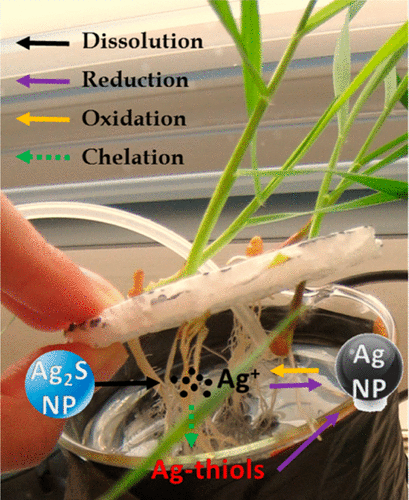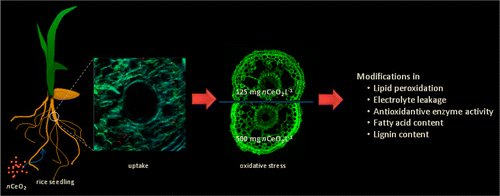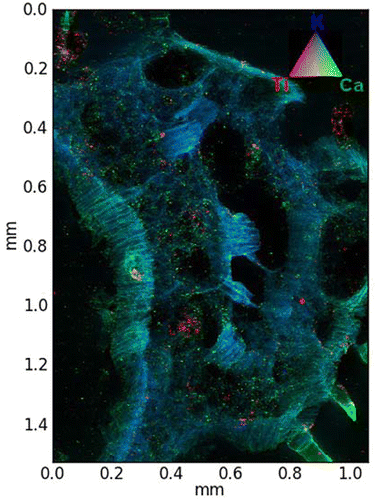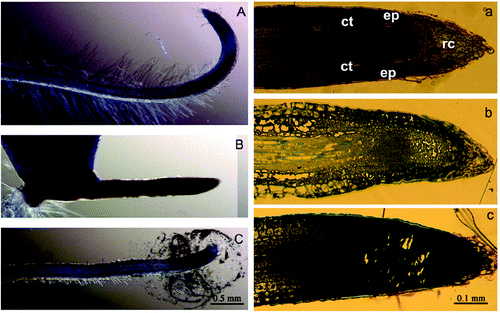Plants
Identification and speciation of nanoparticles in plants
 |
A. E. Pradas del Real, V. Vidal, M. Carrière, H. Castillo-Michel, C. Levard, P. Chaurand and G. Sarret, "Silver Nanoparticles and Wheat Roots: A Complex Interplay", Environmental Science & Technology, 8, 51, 5774-5782 (2017). |
 |
C. M. Rico, M. I. Morales, R. McCreary, H. Castillo-Michel, A. C. Barrios, J. Hong, A. Tafoya, W.-Y. Lee, A. Varela-Ramirez and J. R. Peralta-Videa, "Cerium oxide nanoparticles modify the antioxidative stress enzyme activities and macromolecule composition in rice seedlings", Environmental science & technology, 47 14110-14118 (2013). |
Cerium oxide nanoparticles (nCeO2) have been shown to have significant interactions in plants; however, there are limited reports on their impacts in rice (Oryza sativa). Given the widespread environmental dispersal of nCeO2, it is paramount to understand its biochemical and molecular impacts on a globally important agricultural crop, such as rice. This study was carried out to determine the impact of nCeO2 on the oxidative stress, membrane damage, antioxidant enzymes’ activities, and macromolecular changes in the roots of rice seedlings. Rice seeds (medium amylose) were grown for 10 days in nCeO2 suspensions (0–500 mg L–1). Results showed that Ce in root seedlings increased as the external nCeO2 increased without visible signs of toxicity. Relative to the control, the 62.5 mg nCeO2 L–1 reduced the H2O2 generation in the roots by 75%. At 125 mg nCeO2 L–1, the roots showed enhanced lipid peroxidation and electrolyte leakage, while at 500 mg L–1, the nCeO2 increased the H2O2 generation in roots and reduced the fatty acid content. The lignin content decreased by 20% at 500 mg nCeO2 L–1, despite the parallel increase in H2O2 content and peroxidase activities. Synchrotron μ-XRF confirmed the presence of Ce in the vascular tissues of the roots.
 |
A. D. Servin, H. Castillo-Michel, J. A. Hernandez-Viezcas, B. Corral, J. R. Peralta-Videa and J. L. Gardea-Torresdey, "Synchrotron micro-XRF and micro-XANES confirmation of the uptake and translocation of TiO2 nanoparticles in cucumber (Cucumis sativus) plants", Environmental science & technology, 46, 7637–7643 (2012). |
Advances in nanotechnology have raised concerns about possible effects of engineered nanomaterials (ENMs) in the environment, especially in terrestrial plants. In this research, the impacts of TiO2 nanoparticles (NPs) were evaluated in hydroponically grown cucumber (Cucumis sativus) plants. Seven day old seedlings were treated with TiO2 NPs at concentrations varying from 0 to 4000 mg L–1. At harvest, the size of roots and shoots were measured. In addition, micro X- ray fluorescence (micro-XRF) and micro X-ray absorption spectroscopy (micro-XAS), respectively, were used to track the presence and chemical speciation of Ti within plant tissues. Results showed that at all concentrations, TiO2 significantly increased root length (average >300%). By using micro-XRF it was found that Ti was transported from the roots to the leaf trichomes, suggesting that trichomes are possible sink or excretory system for the Ti. The micro-XANES spectra showed that the absorbed Ti was present as TiO2 within the cucumber tissues, demonstrating that the TiO2 NPs were not biotransformed.
 |
L. Yin, Y. Cheng, B. Espinasse, B. P. Colman, M. Auffan, M. Wiesner, J. Rose, J. Liu and E. S. Bernhardt, "19th More than the ions: The effects of silver nanoparticles on Lolium multiflorum &", Environmental Science & Technology, 62, 45 2360-2367 (2011). |
Silver nanoparticles (AgNPs) are increasingly used as antimicrobial additives in consumer products and may have adverse impacts on organisms when they inadvertently enter ecosystems. This study investigated the uptake and toxicity of AgNPs to the common grass, Lolium multiflorum. We found that root and shoot Ag content increased with increasing AgNP exposures. AgNPs inhibited seedling growth. While exposed to 40 mg L−1 GA-coated AgNPs, seedlings failed to develop root hairs, had highly vacuolated and collapsed cortical cells and broken epidermis and rootcap. In contrast, seedlings exposed to identical concentrations of AgNO3 or supernatants of ultracentrifuged AgNP solutions showed no such abnormalities. AgNP toxicity was influenced by total NP surface area with smaller AgNPs (6 nm) more strongly affecting growth than did similar concentrations of larger (25 nm) NPs for a given mass. Cysteine (which binds Ag+) mitigated the effects of AgNO3 but did not reduce the toxicity of AgNP treatments. X-ray spectro-microscopy documented silver speciation within exposed roots and suggested that silver is oxidized within plant tissues. Collectively, this study suggests that growth inhibition and cell damage can be directly attributed either to the nanoparticles themselves or to the ability of AgNPs to deliver dissolved Ag to critical biotic receptors.



